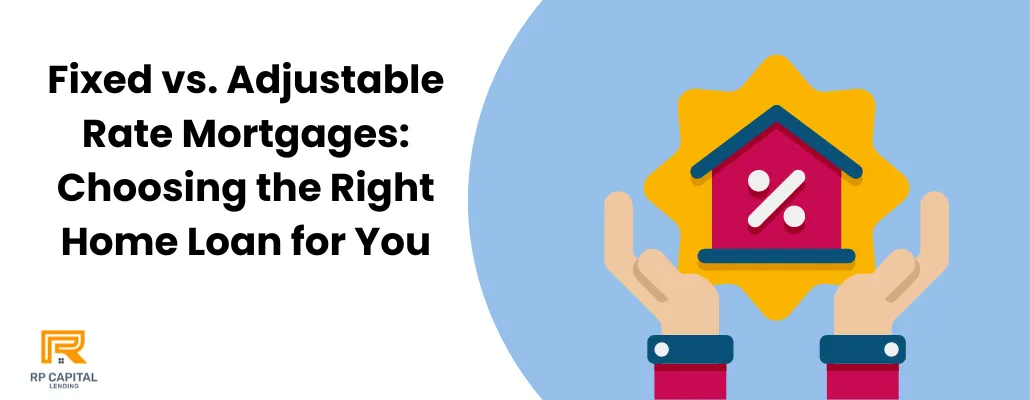Blog

Fixed vs. Adjustable Rate Mortgages: Choosing the Right Home Loan for You
Choosing the right mortgage type—fixed-rate or adjustable-rate mortgage (ARM)—is more than a financial decision; it's a step towards realizing your dream of homeownership. This choice significantly impacts your financial planning and lifestyle for years to come.
A fixed-rate mortgage offers the comfort of knowing exactly what your payments will be for the life of the loan, providing a sense of security and simplicity in budgeting. On the other hand, an ARM might initially lower your payments, offering a tempting flexibility that aligns with certain financial strategies or life stages.
This guide is designed to shed light on each option's nuances, helping you navigate through the complexities and align your mortgage choice with your long-term financial goals and lifestyle aspirations.
Understanding Mortgages: Navigating the Basics of Fixed and Adjustable Rate Mortgages
Mortgages are fundamental to the home-buying process, serving as the bridge between your homeownership dreams and reality.
They come in two primary types: fixed-rate mortgages, which maintain the same interest rate throughout the loan term, ensuring stable and predictable monthly payments, and adjustable-rate mortgages, which offer a lower initial interest rate that adjusts over time based on market conditions.
This fundamental difference affects not just your monthly payments but also your overall financial planning and risk exposure. Understanding these basics is crucial as it lays the foundation for a more informed decision-making process, ensuring you're better equipped to choose a mortgage that aligns with your financial stability and future plans.
Fixed Rate Mortgages Explained: The Stability and Predictability of Fixed Rate Mortgages
A fixed-rate mortgage is the bedrock of financial predictability for many homeowners. By locking in an interest rate for the entirety of your loan term, which can range from 10 to 30 years, you ensure that your mortgage payments remain unchanged regardless of market fluctuations.
This stability is invaluable for long-term financial planning, allowing homeowners to budget with confidence and peace of mind. It's particularly appealing in a rising interest rate environment, where locking in a low rate can save tens of thousands of dollars over the life of the loan.
However, this security comes at a cost, as fixed-rate mortgages typically start with higher interest rates compared to the initial rates of ARMs, making them a more expensive option in the short term.
Adjustable Rate Mortgages (ARM) Explained: The Flexibility of Adjustable Rate Mortgages: A Closer Look
Adjustable-rate mortgages offer an enticing lower initial interest rate, making them an attractive option for those seeking lower initial payments. This initial period of lower payments, typically ranging from one to ten years, is followed by periodic adjustments that align the mortgage's interest rate with current market conditions.
This flexibility can lead to significant savings in the short term and is especially beneficial for those who plan to sell or refinance before the rate adjusts or expect their income to increase over time. However, the potential for rate increases after the initial fixed period introduces a level of uncertainty and risk, as future market conditions can lead to higher payments.
Understanding and preparing for these adjustments is key to ensuring that an ARM aligns with your financial strategy and risk tolerance.
Comparing Fixed and Adjustable Rates: Fixed vs. Adjustable Rate Mortgages: Pros and Cons for Homebuyers
The decision between a fixed and adjustable rate mortgage hinges on a balance between the desire for stability and the willingness to take on risk for potential savings. Fixed-rate mortgages offer peace of mind through consistent payments but often come with higher initial interest rates.
This makes them ideal for individuals planning to stay in their homes long-term or those who prefer predictable budgeting. In contrast, ARMs start with lower interest rates, offering immediate savings but with the caveat of future rate adjustments. This can be beneficial for those confident in their ability to handle potential increases or who plan to move before the fixed-rate period ends.
Weighing these pros and cons is crucial in determining which mortgage type best suits your financial situation, lifestyle, and future plans.
How to Choose the Right Mortgage for You: Tailoring Your Mortgage Choice to Your Financial Goals
Choosing the right mortgage is a personal decision that should be aligned with your financial situation, goals, and tolerance for risk. It requires careful consideration of your current financial stability, future income expectations, and how long you plan to stay in your home.
For those with a stable and predictable income who value consistency and long-term security, a fixed-rate mortgage may be the preferred option. Conversely, if you anticipate a significant increase in your income or plan to move or refinance before the adjustable rate kicks in, an ARM could offer substantial initial savings.
It's also essential to consider the current and projected interest rate environment; in times of low rates, locking in a fixed rate might be advantageous, while in higher rate periods, the initial savings of an ARM could be more appealing.
Conclusion
In conclusion, navigating the choice between fixed and adjustable rate mortgages is a crucial step in the homebuying process, one that hinges on understanding your financial situation, goals, and risk tolerance.
Fixed-rate mortgages offer the security and predictability of consistent payments, ideal for long-term planners and those who value stability. Adjustable-rate mortgages, meanwhile, present an opportunity for initial savings with the flexibility to adapt to changing interest rates, suited for those with a shorter homeownership horizon or expecting future income growth.
By carefully weighing these options against your personal financial landscape, you can make an informed decision that paves the way to a successful and satisfying homeownership experience.
FAQs on Fixed vs. Adjustable Rate Mortgages
1. What are the main differences between fixed and adjustable rate mortgages?
Fixed-rate mortgages offer the same interest rate and monthly payment for the life of the loan, ensuring stability. Adjustable-rate mortgages start with a lower interest rate that can change over time, offering initial savings but with the risk of future increases.
2. Who should consider an adjustable-rate mortgage?
An ARM might suit individuals expecting to increase their earnings, planning to sell or refinance before the rate adjusts, or those who can afford the risk of potential rate increases for initial savings.
3. Can I switch from an ARM to a fixed-rate mortgage?
Yes, refinancing from an ARM to a fixed-rate mortgage is possible, allowing homeowners to lock in a new, stable rate if interest rates or their financial situation change.
4. How do interest rate caps work with ARMs?
Interest rate caps limit how much the interest rate on an ARM can increase at each adjustment period and over the life of the loan, protecting borrowers from drastic payment increases.
5. What factors should I consider when choosing between a fixed and an adjustable-rate mortgage?
Consider your financial stability, how long you plan to stay in your home, your tolerance for payment fluctuations, and the current interest rate environment when deciding between a fixed and an adjustable-rate mortgage.
Disclaimer: Loans only apply to non-owner occupied properties. Rates, terms and conditions offered only to qualified borrowers, may vary upon loan product, deal structure, other applicable considerations, and are subject to change at any time without notice.
Copyright © 2025. All Rights Reserved.


